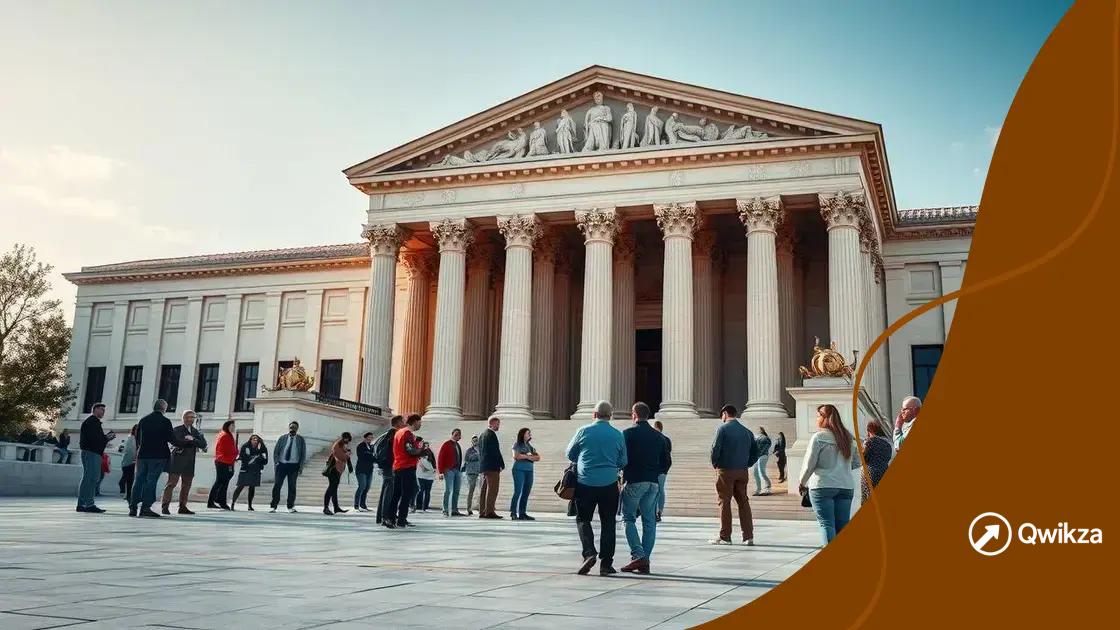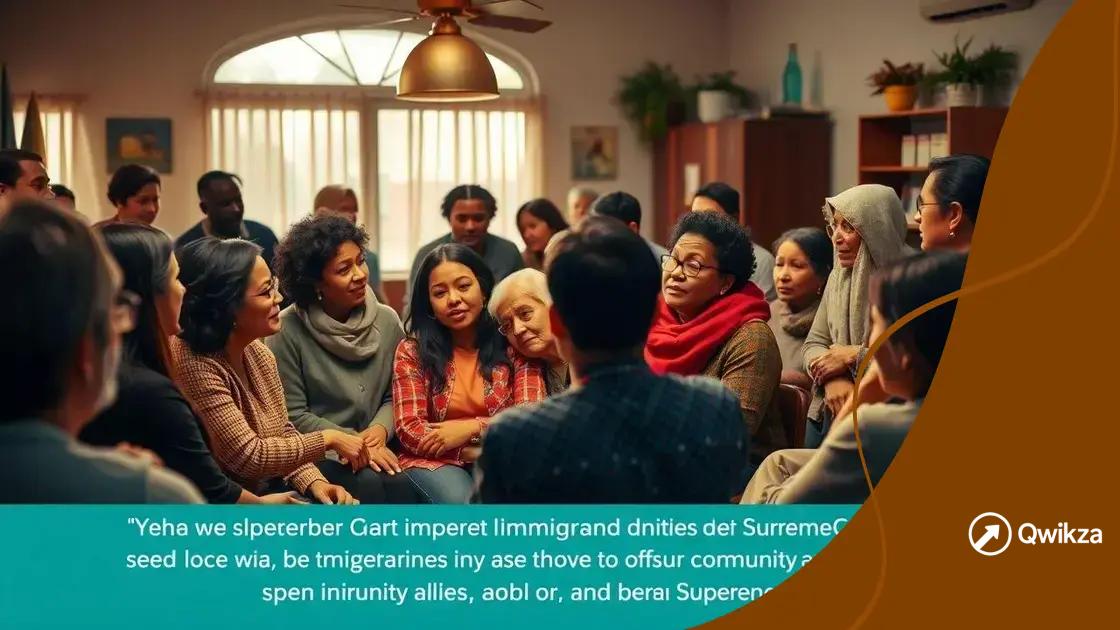Supreme Court decisions on immigration policies: what lies ahead?

Supreme Court decisions on immigration policies significantly impact immigrant communities by shaping legal rights, influencing policies, and dictating available resources for navigating legal challenges.
Supreme Court decisions on immigration policies play a crucial role in defining the legal landscape for millions. Ever wondered how these rulings impact everyday lives and rights? Let’s dive into this important discussion.
Understanding recent immigration policy changes
Understanding recent immigration policy changes is crucial for grasping how they affect individuals and communities. These policies are not only legal measures but reflect the evolving landscape of our society.
Key Policy Changes
Over the past few years, several significant changes have emerged. Each alteration can have profound implications for many people. Here are some of the main changes to consider:
- Revisions to visa application procedures.
- Adjustment of asylum-seeking processes.
- Changes in deportation policies.
- New guidelines on family reunifications.
Policy shifts often stem from multiple factors, including political climates and public opinion. When analyzing these changes, it’s vital to look at how they affect real lives. For example, new visa regulations might simplify or complicate the process for immigrants seeking work, impacting their ability to support families or pursue opportunities.
Moreover, understanding the implications of these policies is essential for proper navigation through the immigration system. Community organizations often provide resources and guidance to help individuals adapt and respond effectively. Many resources include legal counseling, assistance with applications, and educational workshops. Connecting with local immigrant support groups can significantly ease this transition.
Community Impact
Adjusted immigration policies can reshape the dynamics within communities. When laws change, they can affect everything from economic opportunities to cultural exchanges. Immigrants contribute significantly to the workforce, especially in essential industries, thereby influencing the overall economy. Furthermore, community interactions thrive when diverse cultural backgrounds share their traditions, ultimately enriching the social fabric.
The influence of recent policies extends beyond just the individual. Families may face uncertainties, causing emotional and economic strains. Understanding these changes can empower individuals to advocate for themselves and their loved ones. By staying informed, communities can unite in response to challenges.
Key Supreme Court rulings explained
Key Supreme Court rulings significantly shape immigration laws and can have lasting impacts on lives. These decisions address various issues and reflect the current political and social climate.
Notable Cases
Several landmark cases have emerged, each with unique implications. For example, decisions regarding DACA have affected thousands of young immigrants. These rulings have not only defined eligibility criteria but also established pathways for many to remain in the U.S.
One important ruling is United States v. Texas, which focused on immigration enforcement. The outcome halted broad executive actions on immigration, creating uncertainty for many seeking relief from deportation. Another critical ruling, Arizona v. United States, questioned state-level immigration laws, emphasizing that federal authority supersedes state measures.
Impact Analysis
Understanding these decisions helps interpret the current immigration landscape. Policy shifts resulting from court rulings can lead to confusion and fear among affected individuals. Legal experts often analyze these rulings to offer clarity on rights and responsibilities.
- Supreme Court rulings can affect visa applications and renewals.
- Court decisions may influence asylum processes.
- Rulings can reshape community relations and immigrant protections.
- Understanding these implications is crucial for advocacy and support.
As these rulings evolve, they set precedents that future cases might follow. Legal advocacy groups keep a close watch on the Supreme Court to help predict how changes will affect immigrants and their families. Regular updates from these organizations can inform communities about their rights and any necessary actions.
How decisions affect immigrant communities

Decisions made by the Supreme Court greatly impact immigrant communities across the nation. These rulings can change the legal landscape, shaping the future for individuals and families.
Direct Effects on Families
When court rulings alter immigration policies, the consequences can be immediate and profound. Families may face increased uncertainty regarding their status. Many rely on the outcomes of court decisions to remain together.
- Changes in deportation policies affect family reunifications.
- New visa regulations might limit opportunities for family members.
- Legal protections can either expand or decrease for undocumented individuals.
- The emotional toll on families can lead to anxiety and instability.
The impact of these decisions often extends beyond mere legal status. Members of immigrant communities frequently experience social and economic challenges as a result of shifting policies. For example, when deportation policies become strict, individuals may hesitate to seek necessary medical help for fear of being reported and removed. This creates a ripple effect in community health.
Community Dynamics
Supreme Court decisions can also reshape the interactions and relationships within communities. When policies become more restrictive, trust between immigrant communities and law enforcement may diminish. Many immigrants might avoid contacting authorities for assistance, fearing they will face legal repercussions. This can lead to heightened vulnerability.
On the other hand, favorable rulings may empower communities. When courts expand protections for immigrants, individuals often feel more secure and are more likely to participate actively in their communities. Support services like legal aid and advocacy groups thrive in such environments, providing crucial assistance.
Moreover, immigrant communities often come together to advocate for their rights. These collective efforts can lead to greater awareness, support, and change within local systems. Understanding how Supreme Court decisions affect these dynamics helps foster a more inclusive society.
Future implications of current rulings
Future implications of current Supreme Court rulings on immigration policies are critical to understand as they will shape the experiences of countless individuals. As precedents are set, communities can anticipate both challenges and opportunities arising from these legal decisions.
Long-term Effects on Immigration Policies
The outcomes of these rulings often dictate the direction for future legislation. If the court favors certain policies, it could lead to broader acceptance of those measures at the federal and state levels. For instance, rulings that support work permits for undocumented immigrants can encourage similar policies in various states.
- Potential expansion of pathways for citizenship.
- Increased protections for vulnerable immigrant groups.
- Changes that could redefine enforcement priorities.
- Broader access to legal resources for immigrants.
Conversely, if the court issues restrictive rulings, communities may face heightened scrutiny and legal hurdles. This could impact visa applications, asylum procedures, and family reunification processes. It’s vital to observe how these judicial decisions influence agency policies and local laws.
Community Responses to Legal Changes
As the legal landscape shifts, immigrant communities often adapt to the changes, seeking resources to navigate new challenges. Advocacy groups play a crucial role in assisting individuals to understand their rights and options. These organizations can provide:
- Legal aid and counseling services.
- Workshops on navigating new policies.
- Support in advocacy efforts aimed at influencing legislation.
- Resources for community organizing and resilience.
Looking ahead, it’s essential for immigrants and advocates to remain vigilant and informed. Monitoring court decisions and their implications ensures that communities can respond effectively to legal shifts. This preparedness allows for proactive engagement with lawmakers, creating a unified voice that advocates for change.
Navigating legal challenges in immigration
Navigating legal challenges in immigration can be daunting for many individuals. Understanding the processes and knowing where to turn for help is essential for anyone facing these issues. Legal challenges often arise from policy changes, which can leave immigrants unsure of their status and rights.
Common Legal Hurdles
Many immigrants encounter various legal obstacles. These can include complicated visa applications, deportation proceedings, and issues related to asylum. Each situation requires careful attention and understanding of the law.
- Visa denials can lead to significant delays.
- Deportation orders must be challenged promptly.
- Asylum seekers often face lengthy waiting times.
- Documenting evidence for cases is crucial.
Facing these challenges can create fear and confusion. Many individuals might not know where to begin or how to present their case effectively. This is why access to accurate information and legal resources is vital.
Finding Support
Fortunately, there are numerous resources available for immigrants facing legal challenges. Seeking assistance from experienced legal professionals can make a substantial difference. Some of the available support includes:
- Legal aid organizations that offer free or low-cost services.
- Community workshops to educate immigrants about their rights.
- Online resources that provide information on legal processes.
- Support groups that connect individuals facing similar situations.
Staying informed about rights and legal options empowers immigrants to navigate the system effectively. Many find it helpful to connect with local advocacy groups that understand the ins and outs of immigration law. These organizations often provide valuable guidance and representation.
Moreover, collaboration within the community can foster resilience. When individuals come together, they can share experiences and solutions, creating a stronger support network for everyone involved.
In navigating the complex landscape of immigration, understanding the implications of Supreme Court rulings is vital. These decisions can have a significant impact on individuals, families, and communities alike. By staying informed about legal challenges and available resources, immigrants can empower themselves to advocate for their rights. Support networks and legal assistance play essential roles in helping individuals cope with uncertainties. As communities unite to address these challenges, they create a stronger foundation for everyone’s future.
FAQ – Frequently Asked Questions About Immigration Policies and Legal Challenges
What should I do if I receive a deportation order?
If you receive a deportation order, it’s vital to seek legal assistance immediately. There are options to challenge the order and explore available pathways to remain.
How can I find reliable legal aid services?
You can find reliable legal aid services through local nonprofit organizations, community centers, or trusted online resources that provide directories of legal assistance.
What are my rights as an immigrant in the U.S.?
As an immigrant, you have rights, including the right to fair treatment and access to legal counsel. Understanding these rights is essential, so stay informed.
How can community organizations help immigrants?
Community organizations can offer support through legal advice, educational workshops, and resources to help immigrants navigate their rights and challenges.
